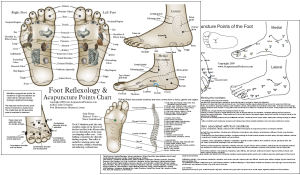Acupuncture & TCM Articles
How To Feel The Pressure And Gain More Energy - Reflexology At Work
Author: James Calvin
Reflexology has been used for many centuries. The method of reflexology, also called "zone therapy", dates back to ancient Egypt, India and China. Evidence of reflexology has even been found in tombs in Egypt. The method of reflexology works by stimulating and applying pressure to certain parts of the hands, or to the feet. Oil, lotion and creams are not used with reflexology. The pressure causes increased circulation and promotes an overall healthier body. The form of reflexology most commonly used today dates back 125 years old to Europe and Russia.
Because hands, feet and ears are very sensitive, pressure on these areas are believed to benefit whole body health. It is estimated that this method can be effective in treating over 93% of sixty-three disorders. Those undergoing reflexology sessions often report increased physical and emotional improvements and feel better with their self-esteem and confidence.
Many benefits of reflexology have been reported. This method can reduce stress from work or home and provide an overall feeling of relaxation. This form of massage also serves to reduce and sometimes eliminate pain in the neck, shoulders and lower back. Reflexology also improves circulation in the body. Another benefit of reflexology is that those receiving regular sessions report an overall sense of well-being, better health and a feeling of reduced stress levels.
In addition, reflexology therapy has been reported to reduce the pain or discomfort caused by a wide variety of medical symptoms. Sessions can help back pain, minor headaches and migraines, menstrual cramps, injuries from sprained muscles, sleep disorders and arthritis some patients report that this therapy also helps infertility. Reflexology can also safely and effectively be used on almost anyone including infants and children, pregnant women, the ill and the elderly.
This technique is a natural way to help both stimulate and relax the body at the same time. Many who experience reflexology report an immediate relief of stress or pain caused by medical conditions.
Learning the techniques of reflexology can be quite simple and easy. Many people can learn the technique and practice it at home or in the office. On-site classes and classes online are offered in many areas to teach the basics of reflexology. Also, books and videos can offer advice on learning the basics of this technique. Many specialty stores offer socks and gloves that can be purchased with the reflexology maps for the hands and feet.
During a traditional reflexology course, students will usually learn the basics of reflexology techniques as well as hand and ear basics. Students also might learn the anatomy of the lower legs including the bones and muscles. Massage techniques and alignment exercises are often taught as well.
While no one is quite sure how reflexology works, there are some theories. One is the "nerve" theory. This theory maintains that there is a connection between the body maps used in reflexology on the feet, hands and ears to the rest of the body. When a certain pressure point is massaged, it will affect the part of the body connected. This is the most widely believed theory on how reflexology works.
Another theory is that reflexology is based on the "meridian" theory. This states that there are at least fourteen energy lines called meridians going up and down in the body. These energy lines have hundreds of pressure points and some of them are in the hands and feet. When pressure is applies to those areas, it creates a sense of well-being.
Another theory on how this technique works is the "vertical" and "horizontal" zone theories. These state that the body is divided in to either ten wide vertical strips or four horizontal strips. Every part of the body falls into one of the strips. Pressure applied to these areas helps that certain body zone.
Professional reflexology sessions can last between forty minutes to an hour. The session usually takes place in a chair with the feet raised. The reflexologies will use their hands and thumbs to help stimulate trouble areas in the body. Typically, after a session, the patient will feel comfortable and relaxed. Sometimes aromatherapy and breathing techniques are used to deepen the affects of reflexology. Breathing techniques used in conjunction with reflexology stimulates a deeper relaxation and better circulation.

Foot Reflexology and Acupuncture Chart
This 8.5" X 11" double sided laminated chart shows the reflex zones on the soles and sides of the feet. Detailed representation of the spine and tissues, organs and glands affected by each spinal nerve.
|
| 